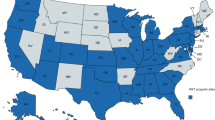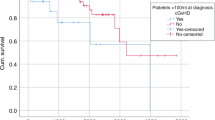Abstract
Patients undergoing hematopoietic cell transplantation (HCT) are at increased risk of chronic health conditions, including second malignant neoplasms and cardiovascular disease. Little is known about health behaviors and cancer screening practices among HCT survivors that could moderate the risk of these conditions. The BM transplant survivor study examined health behaviors and cancer screening practices in individuals who underwent HCT between 1976 and 1998, and survived 2+ years. Health behavior was deemed as high risk, if an individual was a current smoker and if they reported risky alcohol intake (⩾4 drinks per day (males), ⩾3 drinks per day (females)) on days of alcohol consumption. Cancer screening assessment was per American Cancer Society recommendations. There were 1040 survivors: 42.7% underwent allogeneic HCT; 43.8% were female; median time from HCT: 7.4 years (range 2.0–27.7 years). Median age at study participation: 43.8 years (range 18.3–73.0 years). Multivariate regression analysis revealed younger age (<35 years) at study participation (Odds ratio (OR)=4.7; P<0.01) and lower education (<college: OR=2.1; P<0.01) to be significantly associated with high-risk behavior. Survivors were significantly less likely to report high-risk behavior (OR=0.5; P<0.01) and more likely to have had a screening mammogram (OR=2.8; P=0.05) when compared with gender-matched sibling controls (N=309).
This is a preview of subscription content, access via your institution
Access options
Subscribe to this journal
Receive 12 print issues and online access
$259.00 per year
only $21.58 per issue
Buy this article
- Purchase on Springer Link
- Instant access to full article PDF
Prices may be subject to local taxes which are calculated during checkout

Similar content being viewed by others
References
Copelan EA . Hematopoietic stem-cell transplantation. N Engl J Med 2006; 354: 1813–1826.
Cohen A, Bekassy AN, Gaiero A, Faraci M, Zecca S, Tichelli A et al. Endocrinological late complications after hematopoietic SCT in children. Bone Marrow Transplant 2008; 41 (Suppl 2): S43–S48.
Faraci M, Bekassy AN, De Fazio V, Tichelli A, Dini G . Non-endocrine late complications in children after allogeneic haematopoietic SCT. Bone Marrow Transplant 2008; 41 (Suppl 2): S49–S57.
Socie G, Stone JV, Wingard JR, Weisdorf D, Henslee-Downey PJ, Bredeson C et al. Long-term survival and late deaths after allogeneic bone marrow transplantation. Late Effects Working Committee of the International Bone Marrow Transplant Registry. N Engl J Med 1999; 341: 14–21.
Bhatia S, Francisco L, Carter A, Sun CL, Baker KS, Gurney JG et al. Late mortality after allogeneic hematopoietic cell transplantation and functional status of long-term survivors: report from the Bone Marrow Transplant Survivor Study. Blood 2007; 110: 3784–3792.
Bhatia S, Robison LL, Francisco L, Carter A, Liu Y, Grant M et al. Late mortality in survivors of autologous hematopoietic-cell transplantation: report from the Bone Marrow Transplant Survivor Study. Blood 2005; 105: 4215–4222.
Syrjala KL, Langer SL, Abrams JR, Storer BE, Martin PJ . Late effects of hematopoietic cell transplantation among 10-year adult survivors compared with case-matched controls. J Clin Oncol 2005; 23: 6596–6606.
Ranke MB, Schwarze CP, Dopfer R, Klingebiel T, Scheel-Walter HG, Lang P et al. Late effects after stem cell transplantation (SCT) in children--growth and hormones. Bone Marrow Transplant 2005; 35 (Suppl 1): S77–S81.
Sun CL, Francisco L, Kawashima T, Leisenring W, Robison LL, Baker KS et al. Prevalence and predictors of chronic health conditions after hematopoietic cell transplantation: a report from the Bone Marrow Transplant Survivor Study. Blood 2010; 116: 3129–3139.
Nathan PC, Ford JS, Henderson TO, Hudson MM, Emmons KM, Casillas JN et al. Health behaviors, medical care, and interventions to promote healthy living in the Childhood Cancer Survivor Study cohort. J Clin Oncol 2009; 27: 2363–2373.
Travis LB, Gospodarowicz M, Curtis RE, Clarke EA, Andersson M, Glimelius B et al. Lung cancer following chemotherapy and radiotherapy for Hodgkin's disease. J Natl Cancer Inst 2002; 94: 182–192.
Marks DI, Ballen K, Logan BR, Wang Z, Sobocinski KA, Bacigalupo A et al. The effect of smoking on allogeneic transplant outcomes. Biol Blood Marrow Transplant 2009; 15: 1277–1287.
Blanchard CM, Courneya KS, Stein K . Cancer survivor's adherence to lifestyle behavior recommendations and associations with health-related quality of life: results from the American Cancer Society's SCS-II. J Clin Oncol 2008; 26: 2198–2204.
Louie AD, Robison LL, Bogue M, Hyde S, Forman SJ, Bhatia S . Validation of self-reported complications by bone marrow transplantation survivors. Bone Marrow Transplant 2000; 25: 1191–1196.
National Institute on Alcohol Abuse and Alcoholism. The Physician's Guide to Helping Patients with Alcohol Problems. National Institutes of Health: Rockville, MD, 1995 (http://pubs.niaaa.nih.gov/publications/aa56.htm).
National Institute on Alcohol Abuse and Alcoholism. In: Services USDoHaH (ed.), The Clinician's Guide to Helping Patients Who Drink Too Much. National Institutes of Health: Rockville, MD, 2005 (http://pubs.niaaa.nih.gov/publications/practitioner/CliniciansGuide2005/clinicians_guide.htm).
US Preventive Services Task Force. Guide to clinical preventive services. Baltimore, MD, 1996.
Routine cancer screening. ACOG Committee Opinion: Committee on Gynecologic Practice number 128—October 1993. Int J Gynaecol Obstet 1993; 43: 344–348.
American Academy of Family Physicians CoPHaSA. Age charts for periodic heath examinations. American Academy of Family Physicians: Kansas City, MO, 1994.
American Urological Association. Testicular Cancer & testicular self-examination. American Urological Association, Inc.: Baltimore, MD, 1993.
Landier W, Bhatia S, Eshelman DA, Forte KJ, Sweeney T, Hester AL et al. Development of risk-based guidelines for pediatric cancer survivors: the Children's Oncology Group Long-Term Follow-Up Guidelines from the Children's Oncology Group Late Effects Committee and Nursing Discipline. J Clin Oncol 2004; 22: 4979–4990.
Rizzo JD, Wingard JR, Tichelli A, Lee SJ, Van Lint MT, Burns LJ et al. Recommended screening and preventive practices for long-term survivors after hematopoietic cell transplantation: joint recommendations of the European Group for Blood and Marrow Transplantation, the Center for International Blood and Marrow Transplant research, and the American Society of Blood and Marrow Transplantation. Biol Blood Marrow Transplant 2006; 12: 138–151.
Kaste SC, Hudson MM, Jones DJ, Fryrear R, Greenwald CA, Fleming ID et al. Breast masses in women treated for childhood cancer: incidence and screening guidelines. Cancer 1998; 82: 784–792.
Powers A, Cox C, Reintgen DS . Breast cancer screening in childhood cancer survivors. Med Pediatr Oncol 2000; 34: 210–212.
From Cancer Patient to Cancer Survivor: Lost in Transition. National Academy Press: Washington, DC, 2005.
Oeffinger KC, Ford JS, Moskowitz CS, Diller LR, Hudson MM, Chou JF et al. Breast cancer surveillance practices among women previously treated with chest radiation for a childhood cancer. JAMA 2009; 301: 404–414.
Yeazel MW, Oeffinger KC, Gurney JG, Mertens AC, Hudson MM, Emmons KM et al. The cancer screening practices of adult survivors of childhood cancer: a report from the childhood cancer survivor study. Cancer 2004; 100: 631–640.
Hudson SV, Hahn KA, Ohman-Strickland P, Cunningham RS, Miller SM, Crabtree BF . Breast, colorectal and prostate cancer screening for cancer survivors and non-cancer patients in community practices. J Gen Intern Med 2009; 24 (Suppl 2): S487–S490.
Mayer DK, Terrin NC, Menon U, Kreps GL, McCance K, Parsons SK et al. Screening practices in cancer survivors. J Cancer Surviv 2007; 1: 17–26.
CDC: behavioral risk factor surveillance system, prevalence and trends data: 2000–2002. In.
Smith RA, Cokkinides V, von Eschenbach AC, Levin B, Cohen C, Runowicz CD et al. American Cancer Society Guidelines for the early detection of cancer. CA Cancer J Clin 2002; 52: 8–22.
Buetow SA . Testicular cancer: to screen or not to screen? J Med Screen 1996; 3: 3–6.
Westlake SJ, Frank JW . Testicular self-examination: an argument against routine teaching. Fam Pract 1987; 4: 143–148.
Baxter N . Preventive health care, 2001 update: should women be routinely taught breast self-examination to screen for breast cancer? CMAJ 2001; 164: 1837–1846.
Rosolowich V . Breast self-examination. J Obstet Gynaecol Can 2006; 28: 728–730.
Calonge N, Petitti DB, DeWitt TG, Dietrich AJ, Gregory KD, Grossman D et al. Counseling, interventions to prevent tobacco use tobacco-caused disease in adults pregnant women: US Preventive Services Task Force reaffirmation recommendation statement. Ann Intern Med 2009; 150: 551–555.
Hawkins NA, Smith T, Zhao L, Rodriguez J, Berkowitz Z, Stein KD . Health-related behavior change after cancer: results of the American cancer society's studies of cancer survivors (SCS). J Cancer Surviv 2010; 4: 20–32.
Bishop MM, Lee SJ, Beaumont JL, Andrykowski MA, Rizzo JD, Sobocinski KA et al. The preventive health behaviors of long-term survivors cancer and hematopoietic stem cell transplantation compared to matched controls. Biol Blood Marrow Transplant 2009; 16: 207–214.
Emmons K, Li FP, Whitton J, Mertens AC, Hutchinson R, Diller L et al. Predictors of smoking initiation and cessation among childhood cancer survivors: a report from the childhood cancer survivor study. J Clin Oncol 2002; 20: 1608–1616.
Author information
Authors and Affiliations
Corresponding author
Ethics declarations
Competing interests
The authors declare no conflict of interest.
Rights and permissions
About this article
Cite this article
Armenian, S., Sun, CL., Francisco, L. et al. Health behaviors and cancer screening practices in long-term survivors of hematopoietic cell transplantation (HCT): a report from the BMT Survivor Study. Bone Marrow Transplant 47, 283–290 (2012). https://doi.org/10.1038/bmt.2011.60
Received:
Revised:
Accepted:
Published:
Issue Date:
DOI: https://doi.org/10.1038/bmt.2011.60
Keywords
This article is cited by
-
Social support as a moderator of healthcare adherence and distress in long-term hematopoietic cell transplantation survivors
Journal of Cancer Survivorship (2021)
-
Krebs bei Jugendlichen und jungen Erwachsenen
Forum (2020)
-
Pretransplant Psychological Assessment for Stem Cell Treatment
Journal of Health Service Psychology (2018)
-
Differences in health behaviour between recipients of allogeneic haematopoietic SCT and the general population: a matched control study
Bone Marrow Transplantation (2014)
-
Accuracy of self-reported tobacco use status among hematopoietic SCT patients
Bone Marrow Transplantation (2014)



